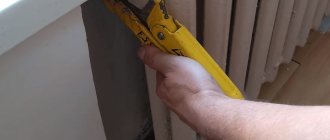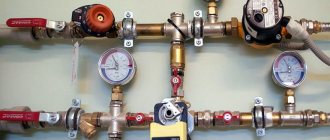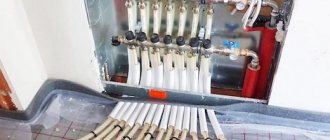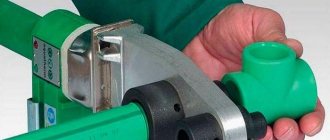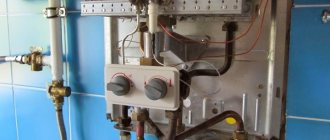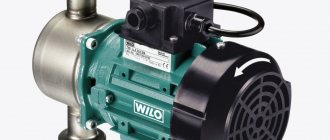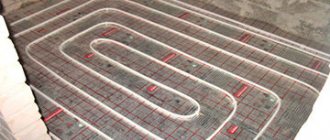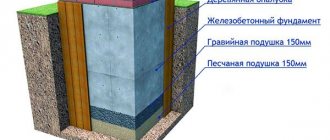When operating an individual heating system in country cottages and dachas, various problems may occur in the equipment or pipeline circuit, accompanied by extraneous sounds. To effectively troubleshoot a problem, sometimes you need to find the answer to the question of why water is babbling in the heating pipes.
Even if various sounds are not a sign of problems, their occurrence leads to a decrease in the comfort of living in the premises of an individual cottage or apartments of a multi-storey building. But more often, if heating pipes are noisy, it signals various types of defects in the heating circuit or equipment, to eliminate which you should know the basic methods of troubleshooting.
Rice. 1 Basic equipment of closed individual heating systems
What to do first, where to go
If a person uses an individual system and understands the issues of repairing heating equipment himself, he does not need to complain anywhere. The heating system is his property, and he can repair it himself by examining the possible problems described below. In cases where the home owner does not have plumbing skills, he will have to call a specialist and pay for the work. It is not difficult to find it through advertising on the Internet or recommendations from friends and relatives.
It's another matter if a person uses central heating. If a resident of an apartment building experiences noise from the radiators, the first thing they should do is call the management company. You can find out the phone number of the management company from your neighbors by studying the information on the walls of the entrance, in receipts, in the contract for the provision of services (for example, intercom service) or in online directories (for example, reformagkh.ru).
If the organization does not respond to calls, you must personally contact the Criminal Code with a statement. If the resident has a document confirming acceptance of the system, the company’s specialists must conduct a free noise diagnosis.
According to current standards, the noise level during the day should be up to 40 dB with the possibility of increasing by 15 units. At night, noise should not exceed 30 dB.
If the problem is not resolved, you need to file a complaint with the housing inspector. If the issue is resolved negatively, all that remains is to contact the prosecutor's office or court. Failure to comply with responsibilities to correct tenant problems is a violation of the law. The facts of the tenant’s appeal to the relevant housing and communal authorities will assist in the consideration of the case.
Other solutions to the problem
First of all, it is necessary to maintain the recommended heating time when connecting polypropylene pipes. Metal-plastic pipelines are bent using a special pipe bender; radiators are installed in a strictly horizontal position.
The entry of solid particles and debris into the heating system is unacceptable. This can cause blockages and temperature changes in certain sections of the pipeline and in radiators. To prevent this from happening, it is necessary to periodically flush the system under water pressure. If the cause of the gurgling cannot be eliminated, you can leave a request on our website or call +7 (926)966-78-68
The most common reason is the presence of air locks
Characteristic sounds: murmur, seething.
Air locks lead to poor circulation, decreased efficiency and breakdowns. Voids in the heating system are formed for the following reasons:
- fluid leak;
- improper filling of the system with coolant;
- concentration of hot vapors, reducing the amount of coolant as it cools.
To avoid problems with air locks, you should adhere to certain rules for installing and servicing equipment, namely:
- Maintain the level of pipes and radiators. A slight misalignment of the battery makes it difficult for air to escape;
- install pressure gauges and thermometers to regulate temperature and pressure;
- in closed systems, provide for the installation of devices for automatic replenishment of coolant;
- install a separator after the boiler to reduce gas in the liquid.
If an air lock has formed , then first you need to find a place where the air has stagnated. The first sign is a significant decrease in temperature in a certain section of the pipe or device. Gurgling and noise of flowing liquid also indicates a traffic jam. When tapping weakly, higher sounds produce voids.
Removing air pockets is done in several ways:
- Using the Mayevsky crane. It is mounted on the top of the radiator (often already included in the basic package of the device). When removing the plug, you need to place a container under the tap, wait until water flows and close it (see photo below).
- Through a valve installed at the highest point of the system. It works on the principle of the Mayevsky crane, but is placed vertically.
- To automatically remove the air plug, a special air vent is used. It is also installed at the top point.
This is what Mayevsky's crane looks like.
In old heating systems you can still find plugs. Bleeding air with their help is fraught with serious problems. You need to be extremely careful to prevent water from splashing into the room. Unscrew the plug slowly, listening to the noise of air and water. The bolt cannot be completely unscrewed for safety reasons.
Troubleshooting Methods
If the gurgling problem is hidden in the wrong pipe diameter or battery installation, only a master plumber can help you. But if the problem is that the pipes are airy, I will tell you how to quickly and step by step remove air from the pipes.
- We find the Mayevsky tap on the opposite edge of the battery from the pipes. Look on the Internet what it looks like so as not to be mistaken.
- We are looking for a very ordinary screwdriver or a special key for the battery. Found it? Now we take any bowl or jar, because water can come out along with the air.
- With one hand we hold the bowl under the Mayevsky tap, with the other we slowly tear off the tap with a screwdriver.
- Don't be alarmed: you will hear a nasty hissing and gurgling sound. Water will soon start dripping.
- When instead of drops of water a stream begins to flow without interruption, you have bled all the air from the system. We tighten the tap tightly and do the same circuit with all the batteries in the apartment.
Incorrect operation of the circulation pump
Characteristic sounds: hum, whistle, howl, murmur, vibration when touched.
The most common problem with a pump is that it runs too fast. The coolant moves through the system at excessive speed, which creates a characteristic noise. According to SNiP 2.04.05-91 “Heating, ventilation and air conditioning”, the speed of movement of the coolant in any area should be no more than 1.5 m/s. As a rule, circulation pumps have 3 operating speeds. For the off-season, in most systems a minimum of 1st speed is sufficient; in severe frosts of -10-15°C it is worth switching to 2nd speed. If a powerful pump is installed that operates at 3rd speed, be sure to switch it to a lower speed and check the result.
If reducing the performance of the circulation pump does not help, the noise may be caused by problems with the impeller or rotor, or wear of parts. Bearing failure leads to vibration. The problem requires replacing damaged components or installing a new pump. Constant sounds in the pump are also observed when the mains voltage is unstable. Changes disrupt the uniform movement of the coolant. As a result, noise appears in the pipeline and batteries, even located far from the pump. It is possible to determine whether the pump is involved in deficiencies only through diagnostics using special equipment.
The noise may also be caused by other problems with the circulation pump, namely:
- incorrect installation of the pump at the inlet and outlet leads to whistling sounds;
- incorrect installation. The rotor must have a strictly horizontal position.
Noise, hum, buzzing, extraneous sounds
There can be many reasons for constant noise in heating radiators. Let's look at them in order:
Wrong pipe diameter
Sometimes heating pipes are of different diameters and are connected by adapters. Because of this, a pressure drop occurs and turbulence appears in the water or coolant. They lead to vibration and extraneous sounds.
Often a change in diameter occurs due to clogged pipes. Sediments can accumulate on their inner walls. This results in reduced throughput.
The only way to solve the problem is to cut off the old pipes and install new ones.
Pressure drops
Due to pressure surges in the heating system, vibration may occur. The reason for this is uneven operation of the circulation pump.
If you live in an apartment building, you can install a bypass. It will help compensate for pressure changes. But it is best to contact the utility companies.
If you have your own heating system, perform diagnostics and maintenance of the circulation pump. And best of all, call a specialist. This can be done using the service for selecting private specialists Profi .
Flow rate
Some people incorrectly calculate the number of radiator sections. Because of this, it is cold in the house or apartment in winter. To compensate for this moment, you can increase the flow rate of water or coolant. But at the same time, unwanted vibrations will occur in the radiators.
Incorrect pipe laying
Many people hide heating pipes in the wall, but do it incorrectly. They simply lay them in a groove, and then cement or plaster them. As a result, the pipe remains rigidly fixed.
Due to heating and cooling, the diameter of the pipe changes. Cracks appear in the concrete and cavities form. They work as a resonator and amplify the sound of water or coolant flowing through the heating system. A hum or buzz appears, the source of which is difficult to detect.
The only solution to the problem is to open the pipes and lay them in soft thermal insulation (see photo). It compensates for expansion and also reduces heat loss.
Thermal insulation for heating pipes.
General wear and tear of systems
The reason for the appearance of extraneous sounds may be wear and tear on the heating system elements. Sources of noise can be faulty or broken:
- Fitting;
- Three-way valve;
- Coolant pressure regulator;
- Radiators;
- Circulation pump;
- Heat source (gas boiler, boiler, etc.).
It is important to remember that sound is transmitted very well through metal pipes. If your gas boiler is noisy, this will affect the volume of the entire system. This option should also be taken into account.
Diameter difference in the heating circuit
Characteristic sounds: buzzing.
In apartment buildings, for reliable and silent operation of the equipment, suitable balancing valves and throttle nuts are installed. If the craftsmen select these parts incorrectly, the water will not reach the upper floors and will begin to quickly flow through the pipes with a hum.
Another reason may be an increase in the number of transitions without balancing the hydraulics, and the use of pipes and taps of a smaller cross-section. When water approaches a channel with a narrower diameter, it encounters resistance, a pressure drop and turbulence appear. If the reason lies not only in the insufficient diameter of the stopcocks, then the problem should be solved by a professional plumber. Most often, a balancing valve has to be installed in front of the risers.
Often the tenant himself creates a problem by trying to independently adjust the coolant inlet into the apartment with a balancing valve. This work should be done by a knowledgeable specialist.
Noise due to leaks or fistulas
Characteristic sounds: humming, bubbling , bubbling, hissing.
If sounds are heard from the central heating system in an apartment, this does not mean that the source of the noise is nearby. Unpleasant sounds are transmitted over distances. Of course, in rooms closer to the noise source, it will be higher. Here we shouldn’t forget about the human factor: some people don’t hear sounds, others won’t be able to close their eyes all night.
In search of a problem, you have to go through almost all the apartments. If the source of the sounds could not be found when visiting the residents, you will have to go down to the basement. The presence of steam is a sign of a coolant leak. It may not be possible to find the location of the leak right away. The pipes in the basement are wrapped in a layer of thermal insulation. But wet marks from the heat conductor on the walls and ground will indicate the approximate area where the fistula is hidden. Subtle leaks are extremely difficult to detect.
You will still have to find the location of the leak, and you need to take measures to temporarily eliminate the problem. The algorithm of actions should be as follows:
- Quickly tie up the leak with improvised materials, place a container under the flowing stream and call a mechanic.
- Before the specialist arrives, turn off the water. It will still not be possible to close the fistula under pressure.
Sometimes you have to wait several days for locksmiths. In order not to leave residents without heat, temporary clamps should be made using several methods:
- Take rubber from a glove or bicycle inner tube.
- Cut strips about 5 cm wide.
- Cover the fistula with several layers of rubber.
- Reinforce the rubber wrapping with wire. Such clamps are also made during leaks between radiator sections.
A special repair clamp, it’s good to have one in case of an unforeseen situation.
If water leaks out at the threaded connections, unscrew the fixing nut slightly. Wind a flax pigtail around the free thread clockwise and tighten the nut back. If the fistula is very small, a self-tapping screw will help.
There are several other methods to stop leaking fluid:
- Soak the fabric in epoxy glue and wrap it around the problem area. The leakage will stop when the glue hardens.
- Put on a metal band with a rubber gasket and tighten with bolts.
- Use cold welding.
Noise in apartments can also cause water to be discharged from the system into the sewer system. This is usually resorted to at the beginning of the heating season. But there are times when plumbers, for various reasons, dump water during the heating season.
Step-by-step instructions for fixing a leak in a heating battery yourself
What to do if there is noise
You can diagnose the operation of the heating system yourself. To do this you need to find out the following:
- source of sounds;
- how often do they occur;
- how pressure changes and temperature changes affect their appearance;
- Does vibration appear simultaneously with sounds?
With hissing and whistling sounds, there is a high probability of a fistula, so you need to find out if there is moisture on the pipes and battery. If a fistula is detected, you need to install a clamp or replace a section, and if the radiator is old, replace it completely. The service life of radiators depends on the material from which they are made:
- steel - 15-20 years;
- aluminum - up to 25 years;
- bimetallic - 25-30 years;
- cast iron - up to 35 years.
To get rid of the air lock, you need to stop the autonomous heating. The air is released through a device designed for this purpose (an automatic float system, a Mayevsky valve, a plug or a water tap) depending on the type of radiator, when the water temperature in the system drops to +25...+30°C. The air comes out for 1-2 minutes. The most difficult thing to ventilate is a cast iron radiator, since the plug in it is fixed with tow and paint.
If the sounds are caused by faulty elements, for example, a torn valve valve or air vent, they must be replaced. If the whistling sounds are accompanied by vibration, the pipes must be additionally secured.
If the owner does not have the skills and necessary tools, it will be difficult for him to fix the problem on his own, and it is better to turn to specialists. They will go around the neighboring apartments, check the entire riser and go down to the basement. If the ventilation valve breaks, calling a repairman is required.
An experienced specialist can quickly determine its cause by the type of noise, and in difficult cases, find it by sequentially going through the options.
Heating battery | Why are batteries noisy?
Clicking, crackling and banging noises due to expansion when heated
One of the reasons for periodic knocking and crackling noises in the heating system is the expansion and contraction of metal structures. The sounds are usually not loud, but occur periodically. This is possible when the fasteners of batteries and pipes are not securely fixed. The movement of coolant in such systems is accompanied by rattling and knocking.
The problem is solved by the following actions:
- Check the fastenings in all rooms. Tighten loose parts.
- If there are rubbing metal pipes that cause grinding noise, they need to be soundproofed.
- If the radiator and pipes hit the wall, install softening pads.
The problem may be inside the wall that the pipe runs through. It is walled up too tightly and cracks at high temperatures, not finding room for expansion. Good plumbers in such places put pieces of other pipes on the heating pipes that are larger in diameter and length than the width of the wall.
Causes of knocking and noise in batteries
Why do you hear metallic knocking, creaking and scraping noises coming from radiators? This is usually caused by one of two reasons:
- The first case is less likely and is associated with insufficiently reliable mounting of the radiator on the wall. If you just moved into an apartment or recently replaced the heating in your house, the installers probably did not secure the radiator properly or used inappropriate brackets. Also, fasteners may simply become loose. Try placing gaskets in the places where the radiator comes into contact with the brackets.
- The second option is due to the fact that suspended particles circulate in open heating systems that are not captured by filters. Getting into the radiators and being supplemented with rusty flakes, they cause knocking sounds. Often these foreign inclusions are retained inside the heating radiator. In this case, the problem cannot be solved without disconnecting and cleaning the battery.
There are several ways to clean a heating radiator, but they are all divided into chemical and mechanical. In the first case, a special agent is poured inside to corrode contaminants, and then the liquid is drained and the radiator is used further. During mechanical cleaning, the radiator is washed with a powerful stream of water, washing away all the dirt from the inside.
Incorrectly installed valve or thermostat
Characteristic sounds: knocking, whistling.
An incorrectly installed valve or thermostat can cause noise in the batteries. The valve only works correctly in one direction. If the technician has mixed up the connections, water will flow from the top of the valve, and not from the bottom, as it should be according to the instructions.
Sectional view of a standard thermostat for a heating system.
The liquid, pressing on the valve, periodically narrows the gap. Sometimes it dangles in the coolant, blocking movement. As a result, a water hammer is created due to a short-term increase in pressure.
Incorrectly installed devices must be replaced or reinstalled.
Methods for cleaning radiators from dirt
During operation of the heating system, dirt accumulates in it: iron oxides, dissolved salts and possible mechanical impurities. But if water moves through the pipes at high speed, then in the radiators the process slows down and the sedimentation of suspended matter increases. Therefore, cleaning radiators is a must.
There are two methods: flushing the entire system together and disconnecting the batteries and cleaning using a compressor unit. Favorable conditions are created in the batteries for the accumulation of dirt, since the coolant slows down the movement in them. To flush, the radiator is connected to the compressor, and dirt is cleaned from it with water pressure.
If you carry out annual preventive maintenance of the entire system, then drastic measures will not be required. It is quite possible to limit yourself to a general flushing of the entire heating circuit with ordinary water. Chemical reagents are used in cases where the coolant does not meet the established parameters and significant deposits of salts and scale appear on the working elements.
After using chemicals, leaks may form in radiators and cracks may appear that were successfully covered with dirt.
To avoid an emergency, all equipment must be checked for functionality before starting the system.
Timely preventive maintenance of all components of the heating system will protect it from complex accidents and save the budget. Find out how to insulate the foundation base from the outside with penoplex at the link.
Blockages in heating radiators
Characteristic noises: crackling, knocking.
There may be a lot of garbage in the system. Pieces of slag that get into the heating system create knocking noises, hitting the walls of pipes and radiators.
In addition, due to blockages, the diameter of the pipes narrows, higher pressure is created and the speed of movement of the coolant increases. To solve the problem, it is enough to do a flush by draining a certain amount of water. To do this, just put the hose on the radiator outlet and open the flush valve.
This process can be interrupted by a piece of scale, which sometimes covers the washer, preventing it from being closed. During flushing, the water in the heating radiators makes a lot of noise, which can alert residents.
Noise you need to pay attention to
To find out why the heating battery is cracking, you first need to check its technical condition. If damage is detected during inspection, the battery is repaired or replaced. If there is no damage, determine the type of noise. The reason why radiators click may be the following:
- improper pipe laying;
- connection of various additional devices (Maevsky tap, shut-off valve, bypass, meter, etc.);
- movement of scale or foreign body trapped in the coolant;
- vibration of the rod and its knocking on the body of the thermal valve as a result of the wrong direction of water flow;
- moving radiators to another location;
- increasing battery power and operating pressure.
Sounds caused by cavitation at high flow rates are not a sign of danger. It’s another matter if they are associated with an increase in internal tension in the system, which can cause a breakthrough.
Reasons for increased internal tension:
- general wear and tear of systems, including valves and taps;
- The upper battery nipples are tighter than the lower ones.
Sounds can be caused by the characteristics of heating boilers. When the draft of solid fuel boilers decreases, crackling and clicking sounds appear, and if a large amount of soot has formed in the diesel fuel boiler, this may be the reason why the heating radiator hums.
Pressure drops near the elevator unit
Residents living on the first floors suffer from excess noise during the heating season. There is an elevator station nearby. Constant noise is associated with the operating characteristics of the equipment.
The elevator has a mixing chamber for hot and cold water. Highly heated water under high pressure is injected into a chamber with cooled water, where the pressure is lower. The difference between different pressures is not without noise. There is always more of it when there is hot water supply in the elevator
Radiators and pipes are good conductors. Sounds generated in the elevator unit are transmitted to several floors below.
Some preventative advice from experts
To ensure free circulation of coolant, the heating system must be flushed before connecting. Over 6-7 years of work, plaque up to 7 mm thick accumulates. This reduces equipment efficiency by 30%. Many people mistakenly believe that plastic pipes are not covered with plaque.
The owners are responsible for flushing systems in private homes. They should remember that aluminum equipment should not be washed with chemicals. This event in multi-storey buildings is carried out by responsible organizations.
When installing a heating system, it is strongly recommended to install Mayevsky taps or purchase radiators with them. It is preferable to use taps instead of valves. The coolant should not be changed frequently. It is necessary to maintain the water level in the expansion tanks. The system should be carefully inspected for any deficiencies and pressure tested.
Why does water gurgle in heating pipes and how to get rid of this sound
When operating an individual heating system in country cottages and dachas, various problems may occur in the equipment or pipeline circuit, accompanied by extraneous sounds.
To effectively troubleshoot a problem, sometimes you need to find the answer to the question of why water is babbling in the heating pipes. Even if various sounds are not a sign of problems, their occurrence leads to a decrease in the comfort of living in the premises of an individual cottage or apartments of a multi-storey building. But more often, if heating pipes are noisy, it signals various types of defects in the heating circuit or equipment, to eliminate which you should know the basic methods of troubleshooting.
Rice. 1 Basic equipment of closed individual heating systems
